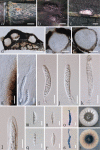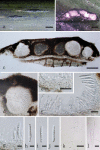Neostagonosporellasichuanensis gen. et sp. nov. (Phaeosphaeriaceae, Pleosporales) on Phyllostachysheteroclada (Poaceae) from Sichuan Province, China
- PMID: 30814907
- PMCID: PMC6389646
- DOI: 10.3897/mycokeys.46.32458
Neostagonosporellasichuanensis gen. et sp. nov. (Phaeosphaeriaceae, Pleosporales) on Phyllostachysheteroclada (Poaceae) from Sichuan Province, China
Abstract
Neostagonosporellasichuanensis sp. nov. was found on Phyllostachysheteroclada collected from Sichuan Province in China and is introduced in a new genus Neostagonosporella gen. nov. in this paper. Evidence for the placement of the new taxon in the family Phaeosphaeriaceae is supported by morphology and phylogenetic analysis of a combined LSU, SSU, ITS and TEF 1-α DNA sequence dataset. Maximum-likelihood, maximum-parsimony and Bayesian inference phylogenetic analyses support Neostagonosporella as a distinct genus within this family. The new genus is compared with related genera of Phaeosphaeriaceae and full descriptions and illustrations are provided. Neostagonosporella is characterised by its unique suite of characters, such as multiloculate ascostromata and cylindrical to fusiform, transversely multiseptate, straight or curved ascospores, which are widest at the central cells. Conidiostromata are multiloculate, fusiform to long fusiform or rhomboid, with two types conidia; macroconidia vermiform or subcylindrical to cylindrical, transversely multiseptate, sometimes curved, almost equidistant between septa and microconidia oval, ellipsoidal or long ellipsoidal, aseptate, rounded at both ends. An updated phylogeny of the Phaeosphaeriaceae based on multigene analysis is provided.
Keywords: 2 new taxa; bambusicolous fungi; phylogeny; stem spot; taxonomy.
Figures



Similar articles
-
Additions to Phaeosphaeriaceae (Pleosporales): Elongaticollum gen. nov., Ophiosphaerella taiwanensis sp. nov., Phaeosphaeriopsis beaucarneae sp. nov. and a new host record of Neosetophoma poaceicola from Musaceae.MycoKeys. 2020 Jul 27;70:59-88. doi: 10.3897/mycokeys.70.53674. eCollection 2020. MycoKeys. 2020. PMID: 32821215 Free PMC article.
-
Morpho-molecular diversity of Linocarpaceae (Chaetosphaeriales): Claviformispora gen. nov. from decaying branches of Phyllostachys heteroclada.MycoKeys. 2020 Jul 16;70:1-17. doi: 10.3897/mycokeys.70.54231. eCollection 2020. MycoKeys. 2020. PMID: 32742178 Free PMC article.
-
Two new species of Parastagonospora and a new species of Phaeoseptoriella (Phaeosphaeriaceae, Pleosporales) from grasslands in Yunnan Province, China.MycoKeys. 2024 Oct 10;109:239-263. doi: 10.3897/mycokeys.109.134136. eCollection 2024. MycoKeys. 2024. PMID: 39430415 Free PMC article.
-
A new genus of Bambusicolaceae (Pleosporales) on Corylus avellana (Fagales) from Italy.Biodivers Data J. 2020 Aug 19;8:e55957. doi: 10.3897/BDJ.8.e55957. eCollection 2020. Biodivers Data J. 2020. PMID: 32904352 Free PMC article.
-
Paramyrothecium eichhorniae sp. nov., Causing Leaf Blight Disease of Water Hyacinth from Thailand.Mycobiology. 2022 Feb 24;50(1):12-19. doi: 10.1080/12298093.2022.2027683. eCollection 2022. Mycobiology. 2022. PMID: 35291591 Free PMC article. Review.
Cited by
-
Additions to Phaeosphaeriaceae (Pleosporales): Elongaticollum gen. nov., Ophiosphaerella taiwanensis sp. nov., Phaeosphaeriopsis beaucarneae sp. nov. and a new host record of Neosetophoma poaceicola from Musaceae.MycoKeys. 2020 Jul 27;70:59-88. doi: 10.3897/mycokeys.70.53674. eCollection 2020. MycoKeys. 2020. PMID: 32821215 Free PMC article.
-
Morpho-molecular diversity of Linocarpaceae (Chaetosphaeriales): Claviformispora gen. nov. from decaying branches of Phyllostachys heteroclada.MycoKeys. 2020 Jul 16;70:1-17. doi: 10.3897/mycokeys.70.54231. eCollection 2020. MycoKeys. 2020. PMID: 32742178 Free PMC article.
-
Functional characterization of cutinase genes NsCut1-NsCut4 in Neostagonosporella sichuanensis and their effects on fishscale bamboo.Front Plant Sci. 2025 Apr 8;16:1564651. doi: 10.3389/fpls.2025.1564651. eCollection 2025. Front Plant Sci. 2025. PMID: 40265120 Free PMC article.
-
Reappraisal of Immotthia in Dictyosporiaceae, Pleosporales: Introducing Immotthia bambusae sp. nov. and Pseudocyclothyriella clematidis comb. et gen. nov. Based on Morphology and Phylogeny.Front Microbiol. 2021 May 7;12:656235. doi: 10.3389/fmicb.2021.656235. eCollection 2021. Front Microbiol. 2021. PMID: 34025611 Free PMC article.
-
Nigromargaritatarda gen. et sp. nov. and distribution of an intron position class within Pleosporales.IMA Fungus. 2025 Feb 28;16:e145425. doi: 10.3897/imafungus.16.145425. eCollection 2025. IMA Fungus. 2025. PMID: 40059982 Free PMC article.
References
-
- Abd-Elsalam KA, Tibpromma S, Wanasinghe DN, Camporesi E, Hyde KD. (2016) Equiseticola gen. nov. (Phaeosphaeriaceae), from Equisetum sp. in Italy. Phytotaxa 284: 169–180. 10.11646/phytotaxa.284.3.2 - DOI
-
- Andrie RM, Schoch CL, Hedges R, Spatafora JW, Ciuffetti LM. (2008) Homologs of ToxB, a host-selective toxin gene from Pyrenophoratritici-repentis, are present in the genome of sister-species Pyrenophorabromi and other members of the Ascomycota. Fungal Genetics and Biology 45: 363–377. 10.1016/j.fgb.2007.10.014 - DOI - PubMed
-
- Ariyawansa HA, Camporesi E, Thambugala KM, Mapook A, Kang J-C, Alias SA, Chukeatirote E, Thines M, Mckenzie EHC, Hyde KD. (2014) Confusion surrounding Didymosphaeria—phylogenetic and morphological evidence suggest Didymosphaeriaceae is not a distinct family. Phytotaxa 176: 102–119. 10.11646/phytotaxa.176.1.12 - DOI
LinkOut - more resources
Full Text Sources
